Effects of Incubation Temperature and Sludge Addition on Soil Organic Carbon and Nitrogen Mineralization Characteristics in Degraded Grassland Soil
Abstract
:1. Introduction
2. Materials and Methods
2.1. Soil and Sludge Samples
2.2. Experimental Design
2.3. Soil Carbon and Nitrogen Mineralization Determination
2.4. Soil Nutrients and Enzyme Activity Determination
2.5. Statistical Analysis
3. Results
3.1. Soil Chemical Properties
3.2. Soil Enzyme Activities
3.3. Stoichiometric Characteristics of Soil Chemical Properties and Enzyme Activities
3.4. SOC and Nitrogen Mineralization Characteristics
3.5. Factors Impacting the Variation of SOC and Nitrogen Mineralization
4. Discussion
4.1. Soil Nutrients and Enzyme Activity
4.2. Soil Nutrient and Enzyme Stoichiometry and Cumulative Carbon and Nitrogen Mineralization
4.3. Factors Impacting the Variation of Soil Carbon and Nitrogen Mineralization
5. Conclusions
Author Contributions
Funding
Data Availability Statement
Conflicts of Interest
References
- Chen, J.; Chen, J.Z.; Tan, M.Z.; Gong, Z.T. Soil degradation: A global problem endangering sustainable development. J. Geogr. Sci. 2002, 12, 243–252. [Google Scholar]
- Ferreira, C.S.; Seifollahi, A.S.; Destouni, G.; Ghajarnia, N.; Kalantari, Z. Soil degradation in the European Mediterranean region: Processes, status and consequences. Sci. Total Environ. 2022, 805, 150106. [Google Scholar] [CrossRef]
- Ding, A.; Zhang, R.R.; Hao, N.H.; He, X.; Ma, J.; Nan, J.; Li, G.B. Life cycle assessment of sewage sludge treatment and disposal based on nutrient and energy recovery: A review. Sci. Total Environ. 2021, 769, 144451. [Google Scholar] [CrossRef]
- Xie, S.; Tran, H.; Pu, M.; Zhang, T. Transformation characteristics of organic matter and phosphorus in composting processes of agricultural organic waste: Research trends. Mater. Sci. Energy Technol. 2023, 6, 331–342. [Google Scholar] [CrossRef]
- Smith, P.; Fang, C.; Dawson, J.J.; Moncrieff, J.B. Impact of global warming on soil organic carbon. Adv. Agron. 2008, 97, 1–43. [Google Scholar]
- Fernandes, S.A.P.; Bettiol, W.; Cerri, C.C. Effect of sewage sludge on microbial biomass, basal respiration, metabolic quotient and soil enzymatic activity. Appl. Soil Ecol. 2005, 30, 65–77. [Google Scholar] [CrossRef]
- Paz-Ferreiro, J.; Gasco, G.; Gutiérrez, B.; Mendez, A. Soil biochemical activities and the geometric mean of enzyme activities after application of sewage sludge and sewage sludge biochar to soil. Biol. Fertil. Soils 2012, 48, 511–517. [Google Scholar] [CrossRef]
- Sastre, C.I.; Lobo, M.C.; Beltrán, H.R.I.; Poggi, V.H.M. Remediation of saline soils by a two-step process: Washing and amendment with sludge. Geoderma 2015, 247, 140–150. [Google Scholar] [CrossRef]
- Yue, Y.; Cui, L.; Lin, Q.M.; Li, G.T.; Zhao, X.R. Efficiency of sewage sludge biochar in improving urban soil properties and promoting grass growth. Chemosphere 2017, 173, 551–556. [Google Scholar] [CrossRef]
- Ahmad, A.; Chowdhary, P.; Khan, N.; Chaurasia, D.; Varjani, S.; Pandey, A.; Chaturvedi, P. Effect of sewage sludge biochar on the soil nutrient, microbial abundance, and plant biomass: A sustainable approach towards mitigation of solid waste. Chemosphere 2022, 287, 132112. [Google Scholar] [CrossRef]
- Geng, Z.; Xiao, L.; Li, Z.B.; Li, P.; Yao, K.H.; Chen, Y.X. Impacts of Adding Municipal Sewage Sludge on Soil Enzyme Activity and Stoichiometry in a Chinese Loess Soil. Pol. J. Environ. Stud. 2022, 31, 3031–3041. [Google Scholar] [CrossRef]
- Geng, Y.; Baumann, F.; Song, C.; Zhang, M.; Shi, Y.; Kühn, P.; Scholten, T.; He, J. Increasing temperature reduces the coupling between available nitrogen and phosphorus in soils of Chinese grasslands. Sci. Rep. 2017, 7, 43524. [Google Scholar] [CrossRef]
- Qi, R.M.; Li, J.; Lin, Z.; Li, Z.J.; Li, Y.T.; Yang, X.D.; Zhang, J.J.; Zhao, B.Q. Temperature effects on soil organic carbon, soil labile organic carbon fractions, and soil enzyme activities under long-term fertilization regimes. Appl. Soil Ecol. 2016, 102, 36–45. [Google Scholar] [CrossRef]
- Wallenstein, M.; Allison, S.D.; Ernakovich, J.; Steinweg, J.M.; Sinsabaugh, R. Controls on the temperature sensitivity of soil enzymes: A key driver of in situ enzyme activity rates. In Soil Enzymology; Springer: Berlin/Heidelberg, Germany, 2011; pp. 245–258. [Google Scholar]
- Wang, Q.K.; Zhao, X.C.; Chen, L.C.; Yang, Q.P.; Chen, S.; Zhang, W.D. Global synthesis of temperature sensitivity of soil organic carbon decomposition: Latitudinal patterns and mechanisms. Funct. Ecol. 2019, 33, 514–523. [Google Scholar] [CrossRef]
- Xiao, L.; Liu, G.B.; Li, P.; Xue, S. Ecological stoichiometry of plant-soil-enzyme interactions drives secondary plant succession in the abandoned grasslands of Loess Plateau, China. Catena 2021, 202, 105302. [Google Scholar] [CrossRef]
- Tan, Q.; Wang, G.; Smith, M.D.; Chen, Y.; Yu, Q. Temperature patterns of soil carbon: Nitrogen: Phosphorus stoichiometry along the 400 mm isohyet in China. Catena 2021, 203, 105338. [Google Scholar] [CrossRef]
- Pedra, F.; Polo, A.; Ribeiro, A.; Domingues, H. Effects of municipal solid waste compost and sewage sludge on mineralization of soil organic matter. Soil Biol. Biochem. 2007, 39, 1375–1382. [Google Scholar] [CrossRef]
- Davidson, E.A.; Janssens, I.A. Temperature sensitivity of soil carbon decomposition and feedbacks to climate change. Nature 2006, 440, 165–173. [Google Scholar] [CrossRef] [PubMed]
- Pérez, L.A.L.; Delgado, G.; Párraga, J.; Delgado, R.; Almendros, G.; Aranda, V. Evolution of organic matter fractions after application of co-compost of sewage sludge with pruning waste to four Mediterranean agricultural soils. A soil microcosm experiment. Waste Manag. 2010, 30, 1957–1965. [Google Scholar] [CrossRef] [PubMed]
- Zhang, X.; Zhao, Y.; Zhu, L.J.; Cui, H.Y.; Jia, L.M.; Xie, X.Y.; Li, J.M.; Wei, Z.M. Assessing the use of composts from multiple sources based on the characteristics of carbon mineralization in soil. Waste Manag. 2017, 70, 30–36. [Google Scholar] [CrossRef] [PubMed]
- Chen, L.J.; Jiang, Y.J.; Liang, C.; Luo, Y.; Xu, Q.S.; Han, C.; Zhao, Q.G.; Sun, B. Competitive interaction with keystone taxa induced negative priming under biochar amendments. Microbiome 2019, 7, 77. [Google Scholar] [CrossRef] [PubMed]
- Ribbons, R.R.; Levy, B.D.J.; Masse, J.; Grayston, S.J.; McDonald, M.A.; Vesterdal, L.; Prescott, C.E. Linking microbial communities, functional genes and nitrogen-cycling processes in forest floors under four tree species. Soil Biol. Biochem. 2016, 103, 181–191. [Google Scholar] [CrossRef]
- Zhang, J.B.; Cai, Z.C.; Müller, C. Terrestrial N cycling associated with climate and plant-specific N preferences: A review. Eur. J. Soil Sci. 2018, 69, 488–501. [Google Scholar] [CrossRef]
- Wang, X.; Yoo, K.; Wackett, A.A.; Gutknecht, J.; Amundson, R.; Heimsath, A. Soil organic carbon and mineral interactions on climatically different hillslopes. Geoderma 2018, 322, 71–80. [Google Scholar] [CrossRef]
- Zhou, S.; Li, P.; Zhang, Y.; Zhang, N.; Cao, Y. Formation of new erosion-deposition patterns after farmland conversion: The major role of topography. Catena 2023, 231, 107349. [Google Scholar] [CrossRef]
- Hu, H.; Umbreen, S.; Zhang, Y.; Bao, M.; Huang, C.; Zhou, C. Significant association between soil dissolved organic matter and soil microbial communities following vegetation restoration in the Loess Plateau. Ecol. Eng. 2021, 169, 106305. [Google Scholar] [CrossRef]
- Hall, P.J.; Aller, R.C. Rapid, small-volume, flow injection analysis for SCO2, and NH4+ in marine and freshwaters. Limnol. Oceanogr. 1992, 37, 1113–1119. [Google Scholar] [CrossRef]
- Saiya-Cork, K.R.; Sinsabaugh, R.L.; Zak, D.R. The effects of long term nitrogen deposition on extracellular enzyme activity in an Acer saccharum forest soil. Soil Biol. Biochem. 2002, 34, 1309–1315. [Google Scholar] [CrossRef]
- Xiao, L.; Liu, G.B.; Li, P.; Xue, S. Dynamics of soil specific enzyme activities and temperature sensitivities during grassland succession after farmland abandonment. Catena 2021, 199, 105081. [Google Scholar] [CrossRef]
- Kolisnik, T.; Keshavarz-Rahaghi, F.; Purcell, R.V.; Smith, A.N.; Silander, O.K. pyRforest: A comprehensive R package for genomic data analysis featuring scikit-learn Random Forests in R. bioRxiv 2024, 9, 598161. [Google Scholar]
- Oksanen, J.; Blanchet, F.G.; Kindt, R.; Legendre, P.; Minchin, P.R.; O’Hara, R.B.; Simpson, G.L.; Solymos, P.; Stevens, M.H.H.; Wagner, H. Community ecology package. R Package Version 2013, 2, 321–326. [Google Scholar]
- R Core Team. R: A Language and Environment for Statistical Computing; R Foundation for Statistical Computing: Vienna, Austria, 2013. [Google Scholar]
- Ayub, M.A.; Usman, M.; Faiz, T.; Umair, M.; Ul Haq, M.A.; Rizwan, M.; Ali, S.; Zia Ur Rehman, M. Restoration of degraded soil for sustainable agriculture. In Soil Health Restoration and Management; Springer: Berlin/Heidelberg, Germany, 2020; pp. 31–81. [Google Scholar]
- Hu, X.X.; Zhang, Y.X.; Wang, D.; Ma, J.; Xue, K.B.; An, Z.B.; Luo, W.X.; Sheng, Y.Z. Effects of temperature and humidity on soil gross nitrogen transformation in a typical shrub ecosystem in Yanshan Mountain and Hilly Region. Life 2023, 13, 643. [Google Scholar] [CrossRef] [PubMed]
- Song, Y.Y.; Song, C.C.; Hou, A.X.; Ren, J.S.; Wang, X.W.; Cui, Q.; Wang, M.Q. Effects of temperature and root additions on soil carbon and nitrogen mineralization in a predominantly permafrost peatland. Catena 2018, 165, 381–389. [Google Scholar] [CrossRef]
- Lehtinen, T.; Dersch, G.; Söllinger, J.; Baumgarten, A.; Schlatter, N.; Aichberger, K.; Spiegel, H. Long-term amendment of four different compost types on a loamy silt Cambisol: Impact on soil organic matter, nutrients and yields. Arch. Agron. Soil Sci. 2017, 63, 663–673. [Google Scholar] [CrossRef]
- Jakubus, M.; Bakinowska, E.; Gałka, B. The quantitative changes of nutrients in two contrasting soils amended with sewage sludge compost evaluated by various statistical tools. Acta Agric. Scand. Sect. B—Soil Plant Sci. 2018, 68, 39–49. [Google Scholar] [CrossRef]
- De Lucia, B.; Cristiano, G.; Vecchietti, L.; Bruno, L. Effect of different rates of composted organic amendment on urban soil properties, growth and nutrient status of three Mediterranean native hedge species. Urban For. Urban Green. 2013, 12, 537–545. [Google Scholar] [CrossRef]
- Elsalam, H.E.A.; El-Sharnouby, M.E.; Mohamed, A.E.; Raafat, B.M.; El-Gamal, E.H. Effect of sewage sludge compost usage on corn and faba bean growth, carbon and nitrogen forms in plants and soil. Agronomy 2021, 11, 628. [Google Scholar] [CrossRef]
- Jiang, J.; Xiong, Y.; Jiang, H.; De-You, Y.E.; Ya-Jie, S.; Feng-Min, L.I. Soil microbial activity during secondary vegetation succession in semiarid abandoned lands of Loess Plateau. Pedosphere 2009, 19, 735–747. [Google Scholar] [CrossRef]
- Ashraf, M.N.; Jusheng, G.; Lei, W.; Mustafa, A.; Waqas, A.; Aziz, T.; Khan, W.; Hussain, B.; Farooq, M.; Wenju, Z. Soil microbial biomass and extracellular enzyme–mediated mineralization potentials of carbon and nitrogen under long-term fertilization (> 30 years) in a rice–rice cropping system. J. Soils Sediments 2021, 21, 3789–3800. [Google Scholar] [CrossRef]
- Burke, D.J.; Weintraub, M.N.; Hewins, C.R.; Kalisz, S. Relationship between soil enzyme activities, nutrient cycling and soil fungal communities in a northern hardwood forest. Soil Biol. Biochem. 2011, 43, 795–803. [Google Scholar] [CrossRef]
- Meng, C.; Tian, D.S.; Zeng, H.; Li, Z.L.; Chen, H.Y.; Niu, S.L. Global meta-analysis on the responses of soil extracellular enzyme activities to warming. Sci. Total Environ. 2020, 705, 135992. [Google Scholar] [CrossRef] [PubMed]
- Steinweg, J.M.; Dukes, J.S.; Wallenstein, M.D. Modeling the effects of temperature and moisture on soil enzyme activity: Linking laboratory assays to continuous field data. Soil Biol. Biochem. 2012, 55, 85–92. [Google Scholar] [CrossRef]
- Skowrońska, M.; Bielińska, E.J.; Szymański, K.; Futa, B.; Antonkiewicz, J.; Kołodziej, B. An integrated assessment of the long-term impact of municipal sewage sludge on the chemical and biological properties of soil. Catena 2020, 189, 104484. [Google Scholar] [CrossRef]
- Pokharel, P.; Ma, Z.; Chang, S.X. Biochar increases soil microbial biomass with changes in extra-and intracellular enzyme activities: A global meta-analysis. Biochar 2020, 2, 65–79. [Google Scholar] [CrossRef]
- Luo, G.W.; Xue, C.; Jiang, Q.H.; Xiao, Y.; Zhang, F.G.; Guo, S.W.; Shen, Q.R.; Ling, N. Soil carbon, nitrogen, and phosphorus cycling microbial populations and their resistance to global change depend on soil C: N: P stoichiometry. Msystems 2020, 5, 10-1128. [Google Scholar] [CrossRef]
- Sinsabaugh, R.L.; Hill, B.H.; Follstad Shah, J.J. Ecoenzymatic stoichiometry of microbial organic nutrient acquisition in soil and sediment. Nature 2009, 462, 795–798. [Google Scholar] [CrossRef] [PubMed]
- Bárta, J.; Šlajsová, P.; Tahovská, K.; Picek, T.; Šantrůčková, H. Different temperature sensitivity and kinetics of soil enzymes indicate seasonal shifts in C, N and P nutrient stoichiometry in acid forest soil. Biogeochemistry 2014, 117, 525–537. [Google Scholar] [CrossRef]
- Zhang, W.; Liu, W.C.; Xu, M.P.; Deng, J.; Han, X.H.; Yang, G.H.; Feng, Y.Z.; Ren, G.X. Response of forest growth to C: N: P stoichiometry in plants and soils during Robinia pseudoacacia afforestation on the Loess Plateau, China. Geoderma 2019, 337, 280–289. [Google Scholar] [CrossRef]
- Yang, Y.; Liu, B.; An, S. Ecological stoichiometry in leaves, roots, litters and soil among different plant communities in a desertified region of Northern China. Catena 2018, 166, 328–338. [Google Scholar] [CrossRef]
- Chang, Y.B.; Liu, W.G.; Mao, Y.Q.; Yang, T.; Chen, Y.G. Biochar addition alters C: N: P stoichiometry in moss crust-soil continuum in Gurbantünggüt desert. Plants 2022, 11, 814. [Google Scholar] [CrossRef]
- Binh, N.T.; Shima, K. Nitrogen mineralization in soil amended with compost and urea as affected by plant residues supplements with controlled C/N ratios. J. Adv. Agric. Technol. 2018, 5, 8–13. [Google Scholar] [CrossRef]
- Leirós, M.C.; Trasar-Cepeda, C.; Seoane, S.; Gil-Sotres, F. Dependence of mineralization of soil organic matter on temperature and moisture. Soil Biol. Biochem. 1999, 31, 327–335. [Google Scholar] [CrossRef]
- Liu, Y.; Kumar, A.; Tiemann, L.K.; Li, J.; Chang, J.; Xu, L.; He, N. Substrate availability reconciles the contrasting temperature response of SOC mineralization in different soil profiles. J. Soils Sediments 2024, 24, 17–31. [Google Scholar] [CrossRef]
- Engqvist, M.K. Correlating enzyme annotations with a large set of microbial growth temperatures reveals metabolic adaptations to growth at diverse temperatures. BMC Microbiol. 2018, 18, 177. [Google Scholar] [CrossRef] [PubMed]
- Weedon, J.T.; Aerts, R.; Kowalchuk, G.A.; van Logtestijn, R.; Andringa, D.; van Bodegom, P.M. Temperature sensitivity of peatland C and N cycling: Does substrate supply play a role? Soil Biol. Biochem. 2013, 61, 109–120. [Google Scholar] [CrossRef]
- Wei, L.; Zhu, Z.K.; Liu, S.L.; Xiao, M.L.; Wang, J.Y.; Deng, Y.W.; Kuzyakov, Y.; Wu, J.S.; Ge, T.D. Temperature sensitivity (Q10) of stable, primed and easily available organic matter pools during decomposition in paddy soil. Appl. Soil Ecol. 2021, 157, 103752. [Google Scholar] [CrossRef]
- Dai, S.; Li, L.; Ye, R.; Zhu-Barker, X.; Horwath, W.R. The temperature sensitivity of organic carbon mineralization is affected by exogenous carbon inputs and soil organic carbon content. Eur. J. Soil Biol. 2017, 81, 69–75. [Google Scholar] [CrossRef]
- Marzi, M.; Shahbazi, K.; Kharazi, N.; Rezaei, M. The influence of organic amendment source on carbon and nitrogen mineralization in different soils. J. Soil Sci. Plant Nutr. 2020, 20, 177–191. [Google Scholar] [CrossRef]
- Wu, H.L.; Cai, A.D.; Xing, T.T.; Huai, S.C.; Zhu, P.; Xu, M.G.; Lu, C.G. Fertilization enhances mineralization of soil carbon and nitrogen pools by regulating the bacterial community and biomass. J. Soils Sediments 2021, 21, 1633–1643. [Google Scholar] [CrossRef]
- Donhauser, J.; Qi, W.; Bergk Pinto, B.; Frey, B. High temperatures enhance the microbial genetic potential to recycle C and N from necromass in high-mountain soils. Glob. Chang. Biol. 2021, 27, 1365–1386. [Google Scholar] [CrossRef]
- Liu, Y.; Wang, C.H.; He, N.P.; Wen, X.F.; Gao, Y.; Li, S.G.; Niu, S.L.; Butterbach Bahl, K.; Luo, Y.Q.; Yu, G.R. A global synthesis of the rate and temperature sensitivity of soil nitrogen mineralization: Latitudinal patterns and mechanisms. Glob. Chang. Biol. 2017, 23, 455–464. [Google Scholar] [CrossRef]
- Guo, Z.; Han, J.; Li, J.; Xu, Y.; Wang, X. Effects of long-term fertilization on soil organic carbon mineralization and microbial community structure. PLoS ONE 2019, 14, e0211163. [Google Scholar]
- Weintraub, M.N.; Schimel, J.P. Interactions between carbon and nitrogen mineralization and soil organic matter chemistry in arctic tundra soils. Ecosystems 2003, 6, 129–143. [Google Scholar] [CrossRef]
- Tabatabai, M.A.; Ekenler, M.; Senwo, Z.N. Significance of enzyme activities in soil nitrogen mineralization. Commun. Soil Sci. Plant Anal. 2010, 41, 595–605. [Google Scholar] [CrossRef]
- Ali, S.; Liu, K.; Ahmed, W.; Jing, H.; Qaswar, M.; Kofi Anthonio, C.; Maitlo, A.A.; Lu, Z.; Liu, L.; Zhang, H. Nitrogen mineralization, soil microbial biomass and extracellular enzyme activities regulated by long-term N fertilizer inputs: A comparison study from upland and paddy soils in a red soil region of China. Agronomy 2021, 11, 2057. [Google Scholar] [CrossRef]
- Chen, Q.; Hu, Y.; Hu, A.; Niu, B.; Yang, X.; Jiao, H.; Song, L.; Zhang, G. Shifts in the dynamic mechanisms of soil organic matter transformation with nitrogen addition: From a soil carbon/nitrogen-driven mechanism to a microbe-driven mechanism. Soil Biol. Biochem. 2021, 160, 108355. [Google Scholar] [CrossRef]
- Salinas, G.J.R.; Hons, F.M.; Matocha, J.E.; Zuberer, D.A. Soil carbon and nitrogen dynamics as affected by long-term tillage and nitrogen fertilization. Biol. Fertil. Soils 1997, 25, 182–188. [Google Scholar] [CrossRef]

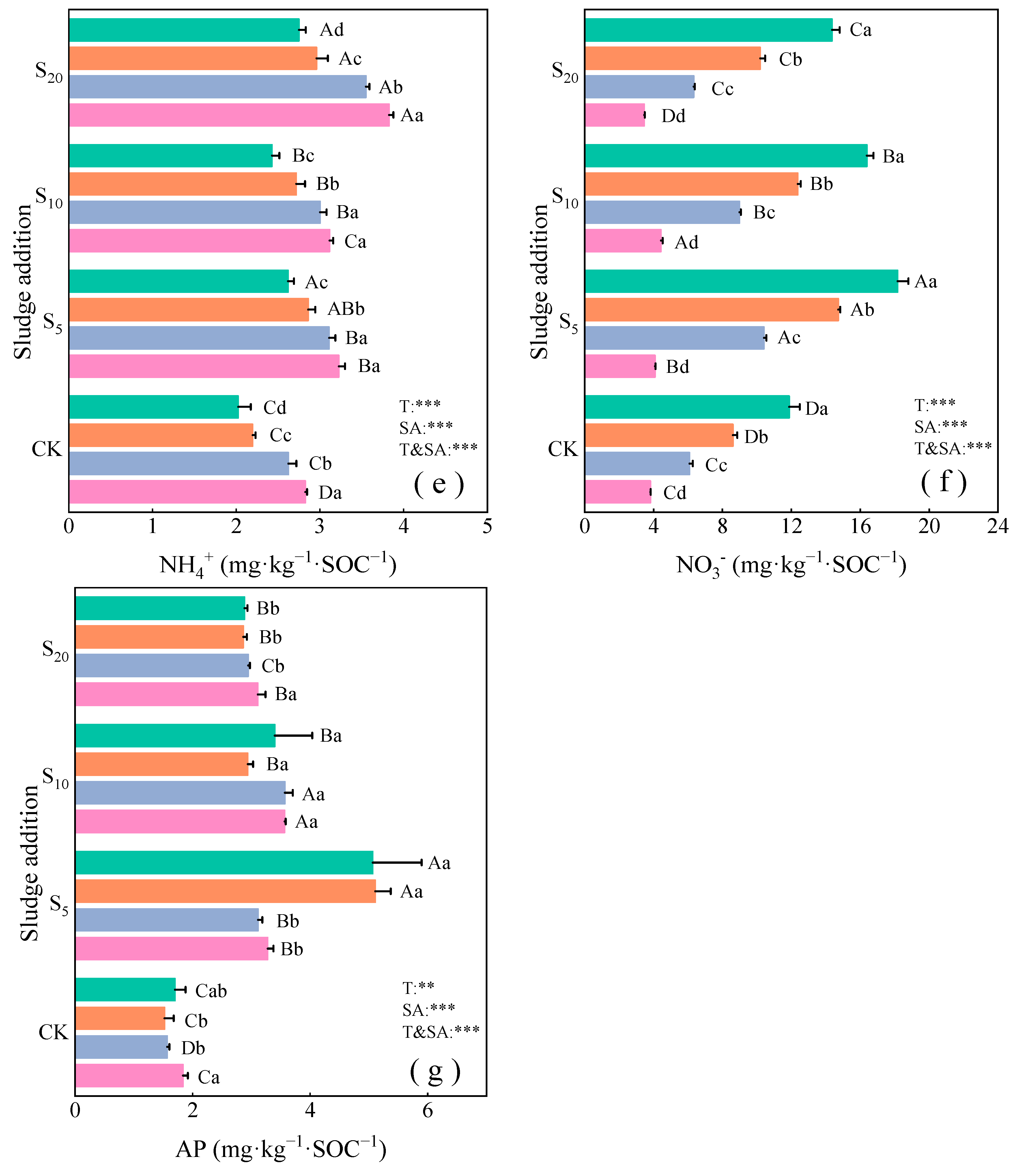
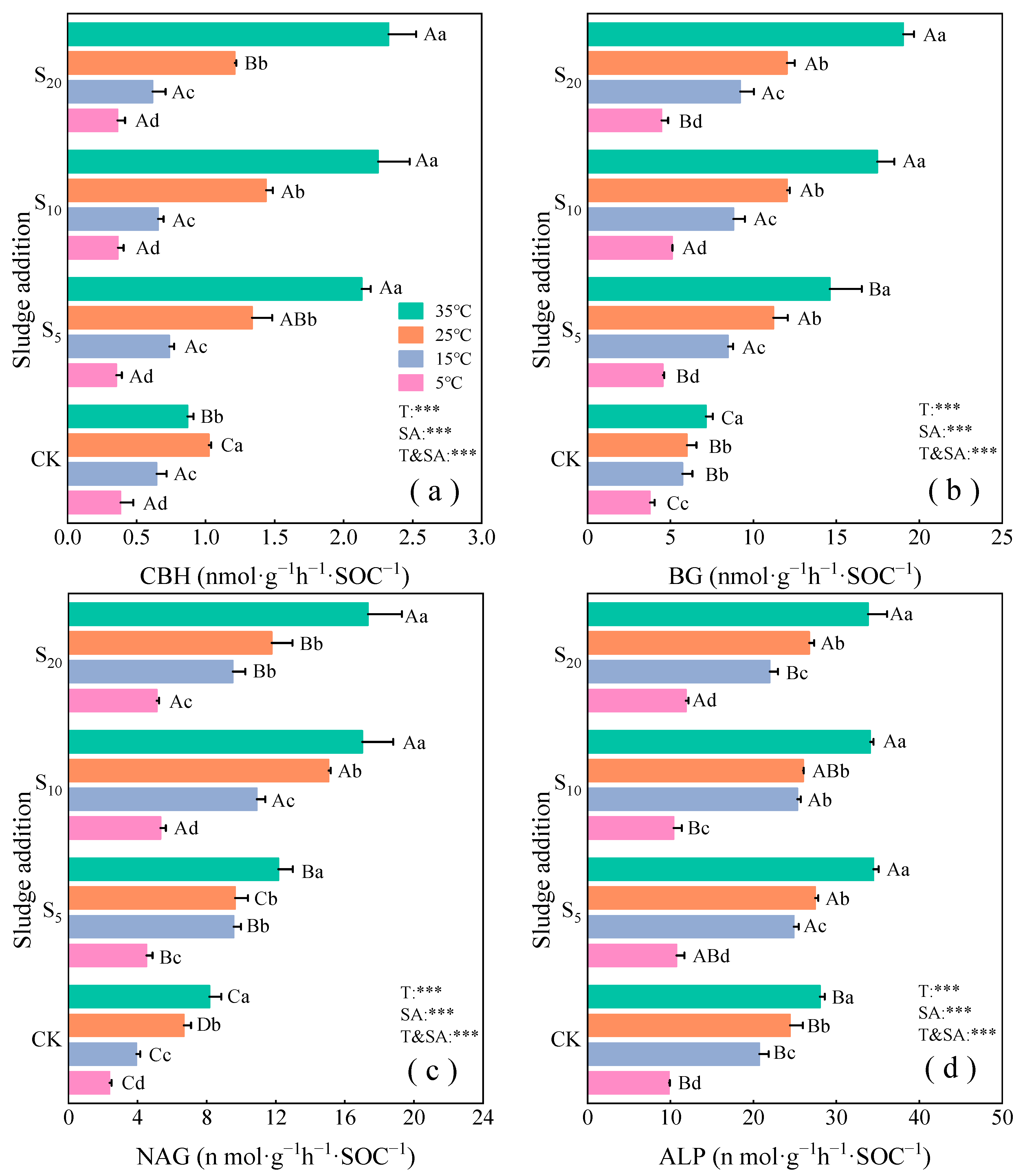
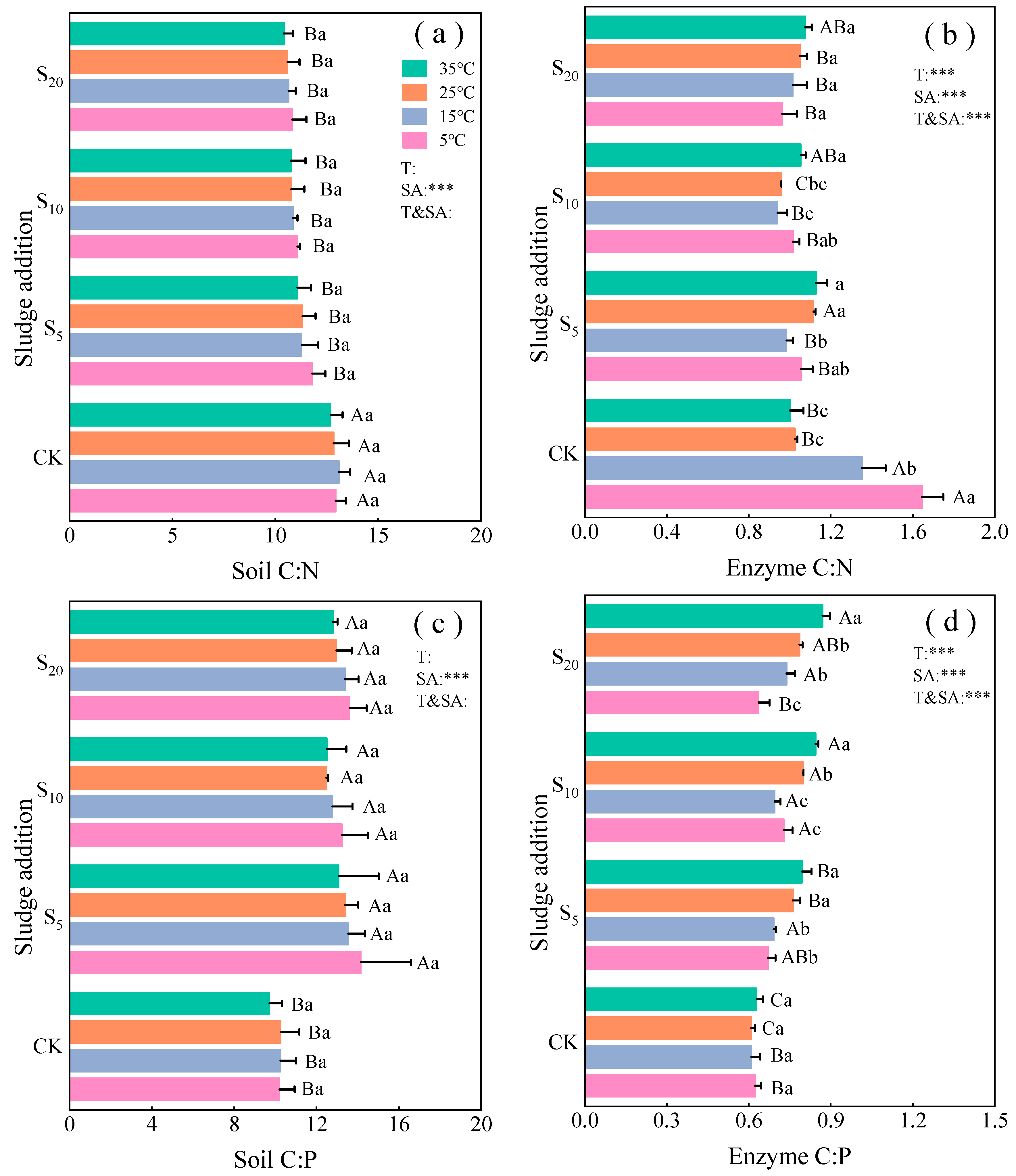
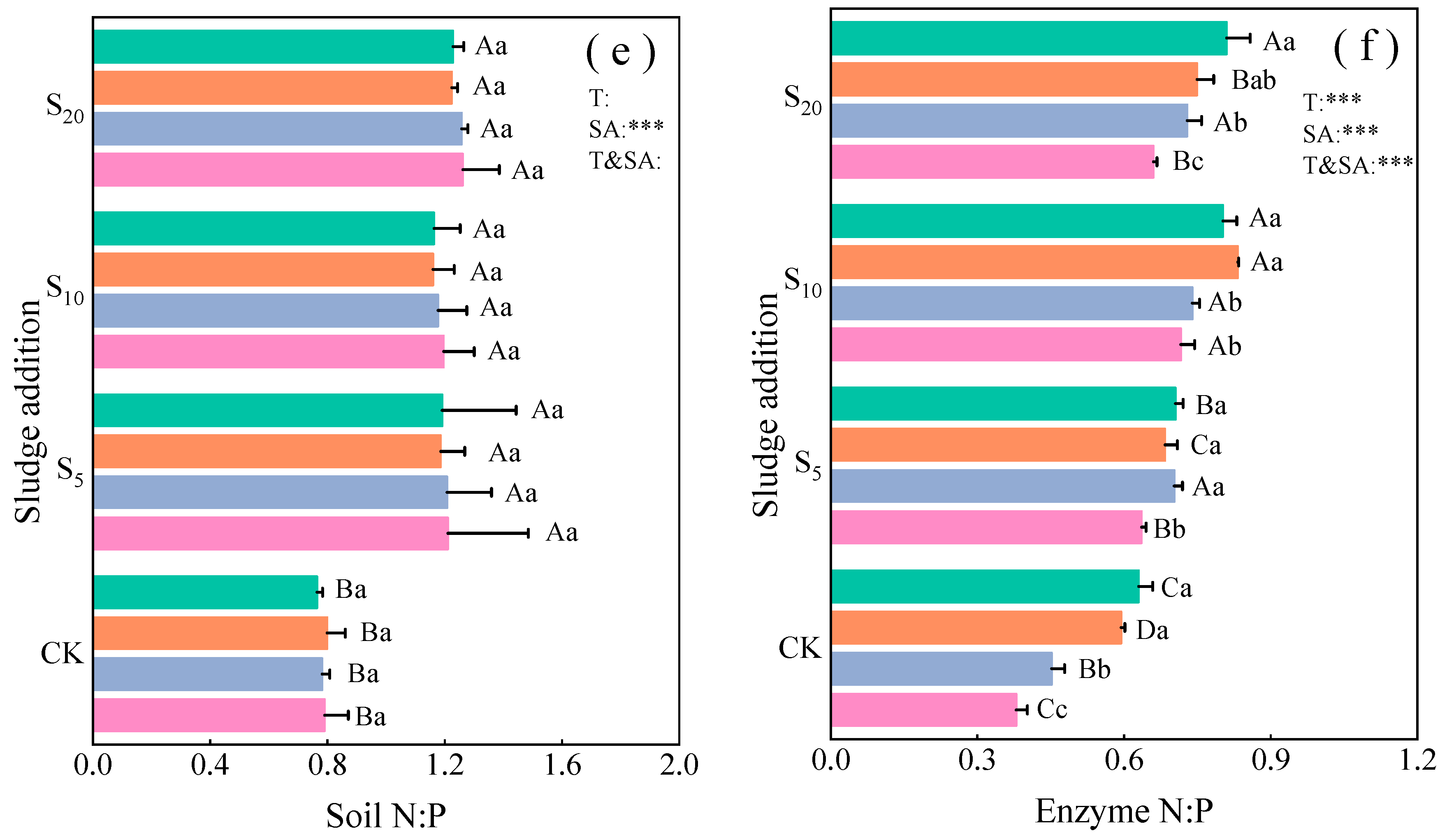


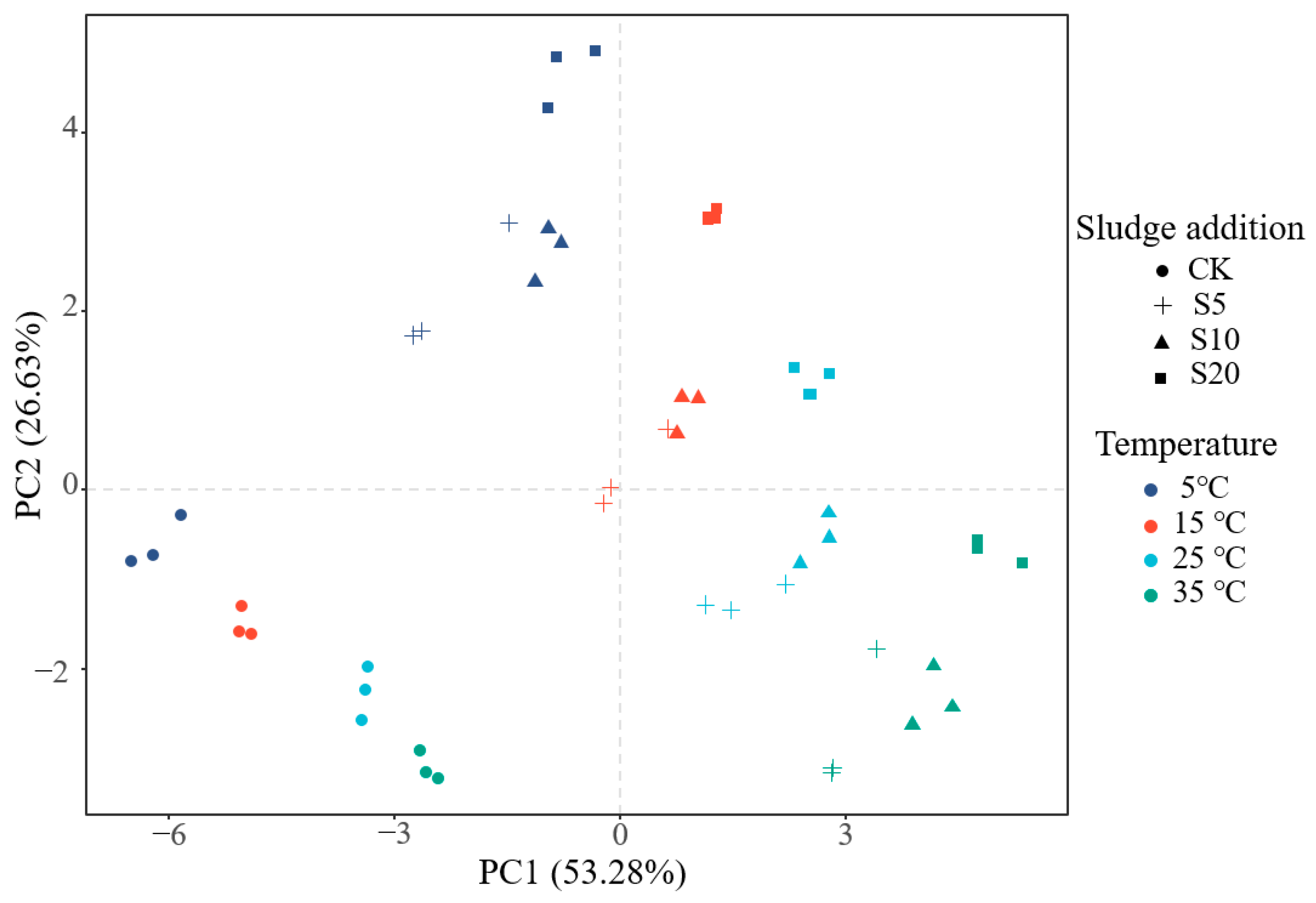



| Treatment | SOC (g·kg−1) | TN (g·kg−1) | TP (g·kg−1) | DOC (mg·kg−1) | NH4+ (mg·kg−1) | NO3− (mg·kg−1) | AP (mg·kg−1) |
|---|---|---|---|---|---|---|---|
| Composted sludge | 237.54 ± 15.70 | 22.23 ± 1.54 | 17.10 ± 0.32 | 4391.11 ± 331.07 | 1154.33 ± 54.85 | 199.68 ± 7.03 | 1070.40 ± 162.24 |
| Grassland soil | 4.89 ± 0.12 | 0.38 ± 0.02 | 0.49 ± 0.04 | 58.97 ± 5.20 | 17.65 ± 1.93 | 18.36 ± 4.38 | 10.41 ± 1.62 |
| Enzyme | Abbreviation | Substrate | Function |
|---|---|---|---|
| Cellobiohydrolase | CBH | 4-MUB-N-acetyl-β-D-glucosaminide | Releases disaccharides from cellulose |
| β-1,4-Glucosidase | BG | 4-MUB-β-D-glucoside | Releases glucose from cellulose |
| β-1,4-N-acetyglucosaminidase | NAG | 4-MUB-β-D-cellobioside | Releases N-acetyl glucosamine from oligosaccharides |
| Alkaline Phosphatase | ALP | 4- MUB-phosphate | Hydrolysis of organophosphates to phosphates |
| Sludge Addition | Incubation Temperature | DOC | NO3− | CBH | BG | NAG | ALP | EnzymeC:P | |
|---|---|---|---|---|---|---|---|---|---|
| Direct | 0.249 | - | −0.105 | 0.516 | - | −0.422 | 0.358 | 0.270 | 0.407 |
| Indirect | 0.062 | 0.666 | −0.036 | 0.252 | −0.077 | 0.377 | - | −0.204 | - |
| Total | 0.311 | 0.666 | −0.141 | 0.768 | −0.077 | −0.045 | 0.358 | 0.066 | 0.407 |
| Sludge Addition | Incubation Temperature | NO3− | AP | CBH | BG | ALP | EnzymeC:P | |
|---|---|---|---|---|---|---|---|---|
| Direct | - | 0.196 | 0.970 | 0.019 | - | - | 0.106 | 0.319 |
| Indirect | 0.229 | 0.683 | - | −0.006 | −0.059 | 0.302 | −0.158 | - |
| Total | 0.229 | 0.879 | 0.970 | 0.013 | −0.059 | 0.302 | −0.052 | 0.319 |
Disclaimer/Publisher’s Note: The statements, opinions and data contained in all publications are solely those of the individual author(s) and contributor(s) and not of MDPI and/or the editor(s). MDPI and/or the editor(s) disclaim responsibility for any injury to people or property resulting from any ideas, methods, instructions or products referred to in the content. |
© 2024 by the authors. Licensee MDPI, Basel, Switzerland. This article is an open access article distributed under the terms and conditions of the Creative Commons Attribution (CC BY) license (https://creativecommons.org/licenses/by/4.0/).
Share and Cite
Min, X.; Xiao, L.; Li, Z.; Li, P.; Wang, F.; Liu, X.; Chen, S.; Wang, Z.; Pan, L. Effects of Incubation Temperature and Sludge Addition on Soil Organic Carbon and Nitrogen Mineralization Characteristics in Degraded Grassland Soil. Agronomy 2024, 14, 1590. https://doi.org/10.3390/agronomy14071590
Min X, Xiao L, Li Z, Li P, Wang F, Liu X, Chen S, Wang Z, Pan L. Effects of Incubation Temperature and Sludge Addition on Soil Organic Carbon and Nitrogen Mineralization Characteristics in Degraded Grassland Soil. Agronomy. 2024; 14(7):1590. https://doi.org/10.3390/agronomy14071590
Chicago/Turabian StyleMin, Xuxu, Lie Xiao, Zhanbin Li, Peng Li, Feichao Wang, Xiaohuang Liu, Shuyi Chen, Zhou Wang, and Lei Pan. 2024. "Effects of Incubation Temperature and Sludge Addition on Soil Organic Carbon and Nitrogen Mineralization Characteristics in Degraded Grassland Soil" Agronomy 14, no. 7: 1590. https://doi.org/10.3390/agronomy14071590






